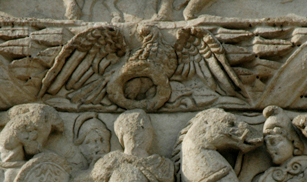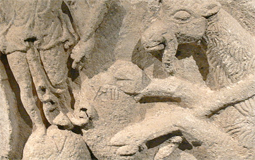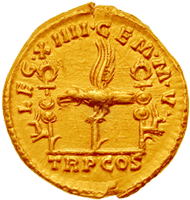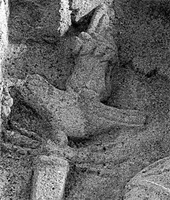
This page created 29 March 2014, and last modified: 29 October 2015 (silver-blue eagle commentary added)

The Quartodecimani is listed (18.17 in Ingo Maier's numbering scheme) as the sixth of the legiones comitatenses under the Magister Militum per Thracias. Its shield pattern (17#1), under the label (17.a) Quarto decimani (except for B, where it is given as the Quartadecimani), is shown in various manuscripts as below:

The shield pattern has a white main field, and yellow boss encircled first by red, and, except for B, a blue band outwards of this. A bird, presumably a not so-well rendered eagle, is depicted in blue (more white in P) at the 12 o'clock position, with wings outspread and facing left (right in B, which being printed, reverses the facings of all the shields); it is perched on (or grasping) the blue band.
The image of an eagle above a central ring (which would thus surround the shield's boss) brings to mind other examples of Roman imagery such as in the Arch of Galerius, where an eagle grasping a wreath of victory is shown over Galerius' (defaced) head:

It may well be that the simple blue ring shown in the surviving Notitia manuscripts (except for B, where it is missing) was depicted as a wreath in the original compilation.
From its name, the unit is clearly derived from Legio XIV / XIIII Gemina (both forms of numbering are attested), long stationed at Carnuntum (near Petronell-Carnuntum and Bad Deutsch-Altenburg in what is now lower Austria); a detachment (145.14) was still stationed there when the Notitia was compiled, under the Dux Pannoniae primae et Norici ripensis; another detachment (145.15) was stationed at Arrabona (modern Gyor in Hungary).

In previous centuries, the symbol of the legion was a capricorn, as shown in the photo above of a 2nd/3rd century monument from Carnuntum. The eagle shown on the shield may not be a reference to a change in "symbol" of the legion, but rather a depiction of the unit's aquila - its Eagle standard; several other shield patterns in the Notitia also show unit standards, such as that of the Herculiani iuniores (9.19). Below left is shown the reverse face of a golden aureus depicting the aquila of Legio XIIII Gemina; the coin was issued in 193 by Septimius Severus, celebrating the legion that elevated him to Emperor. And to the right is the aquila born by Cn. Musius, an eagle-bearer (aquilifer) of the 14th, as depicted on his tombstone in Mainz; in this case the wreath born by the eagle is wrapped around the eagle's wings, rather than held in its beak like that of the Herculiani iuniores, or in its talons, as seemingly the case with the Quartodecimani.

|

|
|
|
|
|
|
|
An interpretation of the pattern's eagle representing a standard is reinforced by noting that the eagle is depicted in blue. According to Cicero, legionary aquilae standards were made of silver, and the Romans depicted silver with blue when using pigments; a prominent example is the depiction of the aquila in the centre of the breastplate of the well-known Augustus of Prima Porta statue, which was coloured blue when first unearthed, although the colours are now invisible to the naked eye.
Three other legiones comitatenses units under the Magister Militum per Thracias, the Tertiodecimani (18.16), the Constantini seniores (18.20), and the Divitenses Gallicani (18.21), have very similar patterns to that of the Quartodecimani, as can be seen below from the following patterns taken from the Paris manuscript:

Given the seemingly unrelated nature of the names of units, this suggests a simultaneous issuance when all four were perhaps detached from their parent units to join a new field army formation (such as that of the Magister Militum per Thracias).
1. Ingo Maier; "Appendix 4: Numeration of the new edition of the compilation 'notitia dignitatum' (Cnd)"; last accessed 26 October 2015. See also for here for numbering examples. Return
2. Marcus Tullius Cicero ("Cicero"); "In Catilinam", 1.9.24; available here in Latin and here in English (last accessed 29 October 2015). Return

Return to the Notitia alphabetical unit list page.
Return to my Notitia index page.